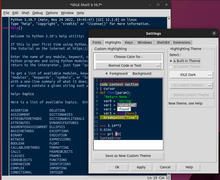|
Tkinter
Tkinter is a binding to the Tk GUI toolkit for Python. It is the standard Python interface to the Tk GUI toolkit,[1] and is Python's de facto standard GUI.[2] Tkinter is included with standard Linux, Microsoft Windows and macOS installs of Python. The name Tkinter comes from Tk interface. Tkinter was written by Steen Lumholt and Guido van Rossum,[3] then later revised by Fredrik Lundh.[4] Tkinter is free software released under a Python license.[5] DescriptionAs with most other modern Tk bindings, Tkinter is implemented as a Python wrapper around a complete Tcl interpreter embedded in the Python interpreter. Tkinter calls are translated into Tcl commands, which are fed to this embedded interpreter, thus making it possible to mix Python and Tcl in a single application. There are several popular GUI library alternatives available, such as Kivy, Pygame, Pyglet, PyGObject, PyQt, PySide, and wxPython. DefinitionsThis term has different meanings in different contexts, but in general it refers to a rectangular area somewhere on the user's display screen. Top-level windowA window which acts as a child of the primary window. It will be decorated with the standard frame and controls for the desktop manager. It can be moved around the desktop and can usually be resized. WidgetThe generic term for any of the building blocks that make up an application in a graphical user interface.
FrameIn Tkinter, the Frame widget is the basic unit of organization for complex layouts. A frame is a rectangular area that can contain other widgets. Child and parentWhen any widget is created, a parent–child relationship is created. For example, if you place a text label inside a frame, the frame is the parent of the label. Minimal applicationBelow is a minimal Python 3 Tkinter application with one widget:[9] #!/usr/bin/env python3
from tkinter import *
root = Tk() # Create the root (base) window
w = Label(root, text="Hello, world!") # Create a label with words
w.pack() # Put the label into the window
root.mainloop() # Start the event loop
For Python 2, the only difference is the word "tkinter" in the import command will be capitalized to "Tkinter".[10] ProcessThere are four stages to creating a widget[11]
These are often compressed, and the order can vary. Simple applicationUsing the object-oriented paradigm in Python, a simple program would be (requires Tcl version 8.6, which is not used by Python on MacOS by default): #!/usr/bin/env python3
import tkinter as tk
class Application(tk.Frame):
def __init__(self, root=None):
tk.Frame.__init__(self, root)
self.grid()
self.createWidgets()
def createWidgets(self):
self.medialLabel = tk.Label(self, text="Hello World")
self.medialLabel.config(bg="#00ffff")
self.medialLabel.grid()
self.quitButton = tk.Button(self, text="Quit", command=self.quit)
self.quitButton.grid()
app = Application()
app.root = tk.Tk()
app.root.title("Sample application")
app.mainloop()
See also
References
External links
|
||||||
